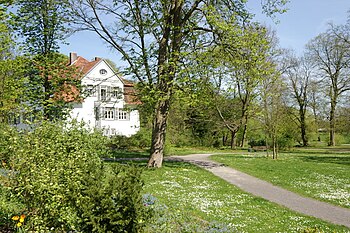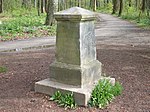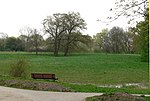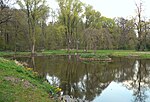Garden across
The Hinübersche Garden in Hanover is one of the earliest landscape gardens in Germany. It is located in the Marienwerder district in the north-west of the city. The Grüner Ring hiking and cycling path leads through the garden .
history
Origin and cultural significance
The construction of the park at Marienwerder Abbey began around 1766 according to plans by Jobst Anton von Hinüber . He was the bailiff of the monastery since 1760 . In 1764 the then legation councilor, chief post commissioner and monastery administrator also became the first director, that is to say head of the newly founded General-Wegebau-Intendance, the first road construction directorate of the Electorate of Hanover. At the request of King George III. In the same year he founded a "Society for the Elevation of Agriculture" with several influential men. It later acquired great importance as the “Albrecht Thaer Society”. The Marienwerder estates became a model farm. We also tested new English devices, machines and cultivation techniques here.
In the vicinity of the monastery there were larger areas of wasteland , dunes , forests and pastures. Eight years later, Hinüber had changed the appearance of the monastery. The Hinübersche Garden, one of the first landscape parks in Germany, was created on an area of 40 hectares .
A trip to England over several months in 1766/67 was decisive for the creation of the park. At that time he visited important English gardens in a "newer taste" and recorded his impressions in a detailed diary. Until the first half of the 19th century, the garden was a must for cultured visitors to the Electorate of Hanover.
renovation
Much of the original structure had been overgrown over the centuries. Much has also been lost from the former furnishings, bridges and pavilions. The Hinübersche Garden in Marienwerder was never redesigned after it was first laid out, so its basic structure has been preserved to this day. Originally it was 35 hectares in size, today only 20 hectares are maintained. As part of the “City as a Garden” project for the Expo 2000 world exhibition , the park, with the exception of the lost buildings, was largely restored according to historical models. Restoration work began in the winter of 1998. In some places trees and bushes have been removed to expose old views and lines of sight. The system of paths was renewed and supplemented, the monuments in the park repaired. There are also new benches for visitors along the paths.
The park
entrance
To the north of Marienwerder Monastery is the actual entrance to the park in the form of a lawn framed by trees. This area was the garden of the old bailiff's house, which no longer stands today. One corner of the house is modeled on it and provided with a plaque donated by the von Hinüber family.
In order not to disturb the garden impression, agricultural buildings were relocated in the park. Many perennials, such as wood anemones, Caucasus forget-me-nots, primroses and funkias have been replanted here. There are also yew trees, honeysuckles, hawthorn and lilacs. This typical garden near the house is intended as a contrast to the landscape park. The role models for this separation lie in England.
A line of sight leads from the garden over the pond to the wooded dune. The obelisk can no longer be seen from here.
Pond with a flower island
The pond with its flower island was designed as the first point of attraction in the garden. The pond bank is flattened and overgrown. The flower island is lush covered with flowers.
Originally there was a grotto on the bank . Presumably there was also a replica of a Venetian gondola on the water. They should be reminiscent of antiquity or Italian gardens from the 16th century.
The Chinese pavilion and the bridge are no longer there. A bench bore the inscription: "One of the most beautiful gifts of heaven is to be able to lead an unnoticed, moderate and quiet life, to organize shadow and light in the soul, and to smile at the beauties of nature."
Quantel wood
The quantel wood is an old forest in which oaks and red beeches grow. It forms a contrast to the open pasture areas in the park. At the other end of the forest is a young oak. It was planted in 1996 and is reminiscent of the mighty royal oak. Its stump still existed until 1950. The royal oak was popularly named in 1846. At that time, King Ernst August of Hanover forbade the felling of the tree, which was “considered by artists and nature lovers to be as gentle as possible”.
On the edge of the Quantelholz, towards the Leineaue , a memorial commemorates the early death of Cecilie von Issendorff , a niece of Hinüber's son Gerhard. Cecilie had an accident at this point in 1818 while riding. The lines on the memorial read:
"If you withered lovely flower - too delicate for the storms of the earth - oh, so early 'took you - who gave you back to us. But your holy image lives for us - in the longing heart - until we see you in Eden's corridor - blooming heavenly. "
Witch tower
The Hexenturm, an artificial ruin , is a folly as an eccentric garden decoration. The tower is located on a dune, to which a path runs within sight of the line and winds up to the dune. This "staging" of the ruin is a clear example of how the gaze of walkers in the park is directed. The pictures that are shown to visitors are similar to landscape painting of the 17th and 18th centuries.
The witch tower was possibly built from the remains of a monastery wing that was demolished in 1724. It is a clear reference to the English role models of the park. The sketch of a comparable building in England can be found in Jobst Anton von Hinüber's diary. The elevated tower offers a good view of the park and the surrounding area. One year before the death of Hinübers, the famous Kiel garden writer Christian Cay Lorenz Hirschfeld visited the garden. At the Hexenturm he admired the view of "the course of the Leine, the city of Hanover with its towers, forests and mountains". A “trick” was used to expand the park beyond its actual limits. Often, avenues stretched far into the landscape, allowing the park to skip the actual estate area.
Former hermitage and druid altar

A path leads from the Hexenturm, along the wooded dune, to the opposite hill. The foundations of a former hermitage can still be seen there. (Paid) hermitages were seen in early landscape gardens as a motif of meditative seclusion and were intended to arouse and mix religious and terrible feelings. Inside, a crucifix, a rosary, pictures of the Virgin Mary and prayer books were said to have been seen. On the altar was a tobacco box, a detail from a novel by the English author Laurence Sterne, which was widely known at the time .
Nearby is the "Druid Altar" made of three large field stones under an old oak. Further downhill there was once a fictional cemetery. Nothing can be seen of the burial mound and the skull attached to an oak. Characters from Sternes novel were “buried” there.
Obelisk on the Glockenberg
The 15 meter high obelisk on the top of the Glockenberg can be seen near the municipal cemetery, which was laid out in the 19th century . Today the obelisk's gaze falls on the new science park of the University of Hanover . Originally one could see from here through alley-like lawns to the witch's tower and to the bailiff's house or the monastery building. This resulted in a triangular axis relationship within the garden. The path to the obelisk is the steepest in the park.
Monument to Gerhard von Hinüber
The way back over the overgrown park dune shows the conscious contrast between the dark forest and the open, light floodplain. A group of trees can be seen from the pond in the direction of Leine. The way there follows an embankment, a terrace edge of the river. Under the trees there is a memorial - a column with a bowl on top - for the son of the park creator Gerhard von Hinüber. The column was erected by his wife Juliane. A sensitive memorial text can be read: “Otto Friedrich Gerhard von Hinüber donated this memorial, his widow and children, who were deeply grieving for him. He was born on November 22nd, 1752 and died on May 27th, 1815. "
From here there are delightful views of the monastery church, the meadow landscape and the Quantelholz.
Audio walk
Since 2013, visitors have had the opportunity to be guided through the different mood rooms of the park with the help of an audio walk and to have their design ideas explained. Audio files and the overview plan for the 45-minute audio walk can be downloaded in advance or accessed at the park entrance using a QR code .
literature
- Hartmut von Hinüber: Jobst Anton, Gerhard, Carl Anton Ludwig and Carl Heinrich v. Over, four personalities from the beginnings of the Royal Agricultural Society in Celle. Reprint of the Albrecht-Thaer-Gesellschaft Celle, 1985.
- Hartmut von Hinüber, Peter Krüger, Siegfried Schildmacher: The Hinübersche Garden in Hanover-Marienwerder. A Masonic Garden , ed. from the Freemason Lodge "Friedrich zum white horses", self-published, Hanover 2011.
- Michael Rohde: Park care plant Hinüberer Garten in Hanover-Marienwerder. Commissioned by the state capital Hanover and the monastery chamber Hanover, 1997
- Michael Rohde: On the history of the Georgengarten and its germ cells: Wallmodengarten and Wangenheimgarten. In: "Back to nature". Idea and history of the Georgengarten in Hannover-Herrenhausen. Exhibition catalog Göttingen, 1997, pp. 11–40
- Eva Benz-Rababah : Garden over there. In: Klaus Mlynek, Waldemar R. Röhrbein (eds.) U. a .: City Lexicon Hanover . From the beginning to the present. Schlütersche, Hannover 2009, ISBN 978-3-89993-662-9 , p. 297.
- Cornelia Kuhnert, Günter Krüger: 111 places in Hanover that you have to see. Emons Verlag, Cologne 2013, ISBN 978-3-95451-086-3 .
- Rainer Schomann (ed.), Urs Boeck : The Hinüberer garden in Hanover. In: Historical gardens in Lower Saxony, catalog for the state exhibition, opening on June 9, 2000 in the foyer of the Lower Saxony state parliament in Hanover. Hannover 2000, pp. 136-137.
Web links
- Brochure The Hinübersche Garden of the City of Hanover, Municipal Green Space Office (PDF; 3.98 MB)
- Family History from Over
- Brief description at hannover.de
- Description, pictures and map of the little garden
- Audio walk through the little garden
Individual evidence
- ↑ a b Brochure Der Hinübersche Garten der Stadt Hannover, Grünflächenamt (PDF, 3.98 MB) accessed on January 10, 2016
- ↑ Website for the audio walk through the Hinüberschen garden in Hanover-Marienwerder
Coordinates: 52 ° 24 ′ 26 ″ N , 9 ° 37 ′ 51 ″ E









